Van Gogh Museum Journal 2003
(2003)– [tijdschrift] Van Gogh Museum Journal–
[pagina 24]
| |
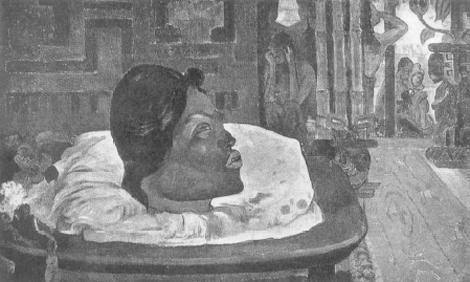 fig. 1
Paul Gauguin, Arii Matamoe (La fin royale), 1890, private collection | |
[pagina 25]
| |
An echoing silence: the critical reception of Gauguin in France, 1903-49
| |
A forgotten artist, a scandalous man: reactions to Gauguin's deathIt was not until the end of August 1903, i.e. three and a half months later, that the news of Gauguin's death arrived in France via Georges-Daniel de Monfreid,Ga naar voetnoot3 who immediately printed an announcement to publicise an event that had passed unnoticed. The art world had become accustomed to the artist's absence and all - or | |
[pagina 26]
| |
almost all - had forgotten him. An exception were his friends Charles Morice, Maurice Denis or indeed Armand Seguin, who had published an important study on him in L'Occident in the spring of 1903.Ga naar voetnoot4 A press agency spread the news of the artist's passing in the first week of September.Ga naar voetnoot5 Ten or so Parisian newspapers then confined themselves to announcing Gauguin's death in three or four lines. A first article that had appeared in Le Temps on 2 September, signed by Thiébault-Sisson, a personal enemy of Gauguin, inspired 13 other dailies,Ga naar voetnoot6 who took over his comments more or less word for word. This text, quoted and sometimes even simply copied in large extracts, spread a libellous account of the artist's life, portraying him as an anarchist, a man with no morals who had abandoned his family, a sexual obsessive, an alcoholic, morphine addict and leper: ‘Gauguin was a sort of anarchist whom a horror of convention and contempt for all rules led to an equally simplistic conception of art and life,’ the critic concluded. This peremptory judgement was to leave a deep impression on people's minds and was to tarnish the painter's image for a long time to come. Around 20 newspapers of all persuasions also printed an obituary notice influenced by another scathing Thiébault-Sisson article that had appeared in Le Petit Bleu on 2 September 1903,Ga naar voetnoot7 again stressing the artist's excesses and his great love of alcohol and ‘popinées.’ The press emphasised the misfortunes of Gauguin's life to prove the failure of his painting and to turn him, as they had Van Gogh, into a accursed artist. Original contributions were rare and numbered only four,Ga naar voetnoot8 while around 30 dailies did not even mention the event for reasons that owed as much to their editorial orientation as to their editorial state. But the silence of Le Gaulois can only be explained by the indifference of Arthur Meyer, its director. For many critics, Gauguin's art had come to an end in 1891; in their eyes the Tahitian episode represented nothing more than a deviation. At the moment of his death, Gauguin was therefore far from an unknown in his own country, but his bad reputation, amplified by libellous articles, did him lasting harm. Misunderstandings and suspicions long dogged the appreciation of his work, as Jean Leymarie noted more than 45 years later: ‘[...] the sudden break between the bourgeois life to which he had conformed in his youth, and the destiny as an artist which he subsequently assumed, with its heroic sacrifices and his ridiculous eccentricities, in revolt against the family, against society and more profoundly against civilisation if not against himself, dissociates him and forever sullies him with ambiguity.’Ga naar voetnoot9 Faced with these negative assessments, Gauguin's friends hastened to publish several articles to defend the work and the memory of an artist they had loved. The poet Charles Morice, with whom Gauguin had in fact been on frosty terms at the end of his life, proved his most active champion after his death. As early as 20 September, Morice protested against the silence of the public powers and the absence of Gauguin in the Musée du Luxembourg, which already contained work by his disciples from Pont-Aven and the Nabis.Ga naar voetnoot10 The following month he committed a second offence by publishing a vibrant plea on Gauguin's behalf: ‘Will justice be done him today,’ he asked, ‘or will | |
[pagina 27]
| |
hatred and incomprehension, even in the face of death, refuse to lay down their arms? [...] I have been told that the man did harm to the artist. Well, the man is no longer here [...].’Ga naar voetnoot11 In his turn, Maurice Denis paid homage to the man who had liberated art from all the restrictions of realism,Ga naar voetnoot12 while Daniel de Monfreid was swift to publish an article in La DépêcheGa naar voetnoot13 in order to counter the libellous words of Marius-Ary Leblond, a well-known colonial writer who had just published an article in the same gazette entitled ‘La vie anarchiste d'un artiste.’Ga naar voetnoot14 On 30 September 1903, Charles Morice carried out a survey among the artists and intellectuals of the symbolist movement: ‘Will you be good enough to summarise, in no more than one page, what you think of Paul Gauguin: his talent, his doctrine, his work, his influence, his attitude?’ The results, published in the Mercure de France,Ga naar voetnoot15 revealed that Gauguin, who had been given such a rough ride by the press, was in reality an artist who was admired and respected by the creators of his generation. Several dubbed him a ‘master’ or ‘genius.’ His work, from which all concerns of imitation had been removed, possessed above all decorative qualities: ‘Gauguin is a decorative expression,’ proclaimed Eugène Carrière in his response to the survey, and such phrases were often repeated to classify Gauguin's art during the entire first half of the 20th century. If his art still appeared excessive in the most conservative eyes, Antoine de la Rochefoucauld prophesied that certain works ‘will soon feature in the Luxembourg, [...] while waiting for the day, ten years of so from now, when the Louvre honours itself by offering up its picture-rails [...]. But what a revolution, what an upheaval to arrive at such a result.’Ga naar voetnoot16 Morice concluded that it was still too soon to measure the depth of the mark left by Gauguin on the art of his time. Everything had still to be done to secure his recognition and analyse his impact on the younger generations. | |
Beginnings of recognitionA few years before his death, Gauguin had been preoccupied with the idea of an exhibition that would be truly representative of his work, with canvases such as Ia orana Maria, Nevermore and, most important of all, Where do we come from? What are we? Where are we going? (fig. 9).Ga naar voetnoot17 He had hoped once again to take advantage of the Exposition Universelle of 1900, when the eyes of the entire world would be turned towards Paris, just as he had done in 1889 with the exhibition at the Café Volpini. But this project did not materialise. By the time France learned of his death it was unfortunately too late to organise a major exhibition. Only a few works were hung in a small, poorly-lit room at the Salon d'Automne, which opened its doors on 31 October 1903. According to the catalogue, the display contained eight pictures,Ga naar voetnoot18 but other accounts indicate there were probably more. These same accounts enable us for the first time to identify some of these works with certainty: Arii Matamoe (La fin royale) (fig. 1), loaned by the collector Henry Lerolle;Ga naar voetnoot19 and Bathers, which belonged to Roger Marx, was also featured, hung in comparison with L'or de leurs corps from the collection of Olivier Sainsère. ‘These two canvases exchange eloquent retorts [...]. With him [Gauguin], under the influence of his genius, he makes us admire the beauty of these and con- | |
[pagina 28]
| |
sent to see in those the stigmata of decadence,’ wrote Charles Morice.Ga naar voetnoot20 But the age was still a long way from joining the critic in singing the praises of a Tahitian Eve. Still, the modest hanging provoked lively emotions among the visitors to the Salon d'Automne, who were struck by the pictures' disturbing beauty.Ga naar voetnoot21 The opening, a few days later, of a major exhibition at the Galerie Vollard,Ga naar voetnoot22 comprising 50 pictures and 23 drawings and monotypes, also confirmed the beginnings of a movement towards favourable recognition of the artist. On this occasion, at a time when Segalen's purchases had not yet made their way to France, the public was introduced for the first time to works from the Marquesas. Also featured were works from the first trip to Tahiti. Vollard, who had waited for Gauguin's death before speculating on his work, was beginning to do some good deals with foreign collectors, mainly Germans and Russians.Ga naar voetnoot23 In June 1905, he once again organised a large show of around 60 works - paintings, watercolours, ceramics and sculptures, which unfortunately did not produce any reaction on the part of the public authorities. ‘I dare not hope that M. Dujardin-Beaumetz [Under-secretary of State for Fine Arts] will deign to venture inside. And yet is it not high time that a work by Paul Gauguin entered the Luxembourg, where so many of those who followed in his wake hang in triumph?’ asked Louis Vauxcelles in Gil Blas on this occasion.Ga naar voetnoot24 After a plan for an exhibition at the Ecole des Beaux-Arts failed to come to fruition,Ga naar voetnoot25 Charles Morice sensed an imminent danger that Gauguin's work would be dispersed and publicly demanded an exhibition of his entire production: paintings, sculptures, prints and ceramics. He even envisaged having the artist's ashes repatriated to Père Lachaise cemetery, in order to provide Gauguin with the funeral ceremony he had been denied.Ga naar voetnoot26 Maurice Denis, too, was indignant about French officials' silence: ‘[...] It is time that we recognised both the value of his work, and the important place it holds in the history of modern art. He is the French painter who has had the greatest influence since Manet. Gauguin was for the generation of 1890 what Manet was for the generation of 1870.’Ga naar voetnoot27 | |
The Salon d'Automne retrospective, 1906It was not until the autumn of 1906, in other words more than three years after Gauguin's death, that a a large-scale retrospective of the artist's work was held at the Paris Salon d'Automne.Ga naar voetnoot28 Numerous collectors participated in the event: 24 supplied at total of 227 works, representing all periods of Gauguin's activity and each listed in the catalogue alongside the names of their owners. Gustave Fayet practically emptied the walls of his apartment in the rue de Bellechasse.Ga naar voetnoot29 Vollard also loaned many works to support his artist's ever-rising reputation: pictures bought for 200 francs during Gauguin's lifetime were now selling for several thousand.Ga naar voetnoot30 The retrospective, presented to the public under good conditions, became the attraction of the Salon d'AutomneGa naar voetnoot31 and gave rise to a number of detailed analyses. The canvases from Brittany had acquired a good patina over time, and those from Tahiti, with their bold simplifications, fit into the decorative tradition that ran from | |
[pagina 29]
| |
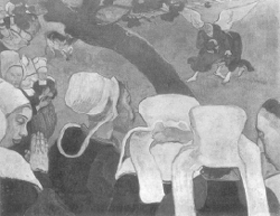 fig. 2
Paul Gauguin, Vision of the sermon, 1888, Edinburgh, National Gallery of Scotland the artists of the Middle Ages to Puvis de Chavannes.Ga naar voetnoot32 Even the inflexible Camille Mauclair seemed won over by the paintings: ‘There is in this Tahitian Giotto [...] a sort of barbaric opulence that moves one, and above all a surprising ornamental ingeniousness.’Ga naar voetnoot33 Morice recalled on this occasion that the French state had refused to grant walls to Gauguin in his lifetime, thus depriving the public of sumptuous decorations that were ‘the very goal, the natural and special goal of his mission.’Ga naar voetnoot34 The exhibition revived hopes for a rehabilitation of this controversial artist, who was still officially ostracised. He was already appearing alongside Cézanne and Van Gogh as a major player and a profound influence on contemporary art. But the public at large, who were accustomed to anecdotal works and for whom Gauguin was practically an unknown, still feared him and preferred to admire ‘d'excellents artistes hospitalisés au musée du Luxembourg.’Ga naar voetnoot35 Opinion remained divided about the masterpieces from the Fayet collection on view - The yellow Christ; Vision of the sermon (fig. 2); a ceramic jardinière; Soyez mystérieuses; Woman with a mango; Two Tahitians; and | |
[pagina 30]
| |
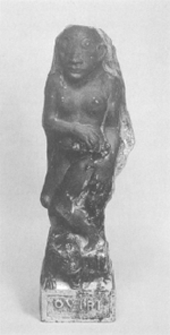 fig. 3
Paul Gauguin, Oviri, 1894, Paris, Musée d'Orsay Oviri, which Fayet had bought in 1905 (fig. 3) - as well as Nevermore from the Fritz Delius collection. Several major works were absent, however, such as Manaò tupapaú,Ga naar voetnoot36 Ia orana Maria from the Manzi collection, and, above all, Where do we come from? What are we? Where are we going?, which then belonged to the great Bordeaux amateur Gabriel Frizeau. The Gauguin retrospective at the 1906 Salon d'Automne was also a sort of homage by younger artists to an older master. Pierre Girieud exhibited a ‘messianic’ work depicting the artist surrounded by his friends and disciples: Paco Durrio, Maurice Denis, Charles Morice, Maurice Sérusier, Daniel de Monfreid, etc. (fig. 4). The filiation from the Gauguin room to the so-called ‘Fauves’ room seems obvious to us today, but few recognised it at the time. One exception was the columnist from L'Art Décoratif, who pointed to the connection whilst putting the painters of the new generation on their guard.Ga naar voetnoot37 Beside these canvases, with their shrill colours, Gauguin's painting seemed almost calm: ‘le calme et la surdité des belles choses.’Ga naar voetnoot38 | |
Between fascination and rejection, 1907-48During the years following the 1906 retrospective at the Salon d'Automne, galleries and dealers proved extremely committed to Gauguin, whose popularity was continually rising.Ga naar voetnoot39 Around 1910, a medium-sized canvas cost between 10,000 and 18,000 francs. Between 1907 and 1911 his works were shown regularly at the Bernheim-Jeune gallery when there were thematic exhibitions,Ga naar voetnoot40 but Vollard remained his most active dealer.Ga naar voetnoot41 From 25 April to 14 May 1910 he staged an exhibition comprising 22 pic- | |
[pagina 31]
| |
tures from every period, including The vision of the sermon (fig. 2) and a large Tahiti scene from 1898, Tahitian pastoral, which he called La frise; the latter was offered to The Metropolitan Museum of Art in New York for 35,000 francs at the start of 1918.Ga naar voetnoot42 By the end of the second decade of the 20th century and the beginning of the 1920s, the Tahitian period was not the only one to attract the attention of the public and connoisseurs: the works of the Brittany period re-emerged at an exhibition of the decorations for Marie Henry's inn at Le Pouldu, held at the Barbazanges gallery in 1919.Ga naar voetnoot43 This gave rise to a number of publicationsGa naar voetnoot44 in which Gauguin was dubbed the founder of synthetismGa naar voetnoot45 and symbolism.Ga naar voetnoot46 While France remained divided between fascination and rejection, foreign art-lovers were showing an active interest in Gauguin, who enjoyed a very different reputation in their countries. In 1926, the Association de l'Art françaisGa naar voetnoot47 organised an important exhibition at Copenhagen, Stockholm and Oslo, consisting of 76 pictures, all of which, except for one,Ga naar voetnoot48 belonged to Scandinavian collections. Among the works shown were Where do we come from? What are we? Where are we going?, recently purchased by the Norwegian amateur J.B. Stang. Denmark, which claimed a share of Gauguin's genius, would dearly have loved to annex him to its national school. A similar ambition could also be sensed in the title of an exhibition held in Paris in December 1926 under the aegis of the grouping Paris-Amérique Latine, on the initiative of Paco Durrio: Hommage au génial artiste francopéruvien Gauguin.Ga naar voetnoot49 On this occasion, the association requested that a commemorative plaque be placed on the house where Gauguin was born, 56, rue Notre-Dame-de-Lorette.Ga naar voetnoot50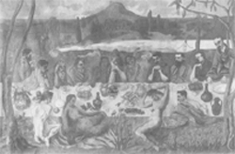 fig. 4
Pierre Girieud, Homage to Paul Gauguin, 1906, Musée de Pont-Aven This plaque, which was unveiled in December 1933, constituted the first official gesture towards an artist who had been born in Paris, but who was still far from being firmly established in his own country. The activities of galleries and associations finally prompted French officials to emerge from their reserve. Several leading figures from the museum world were in the organising committee of the Paris-Amérique Latine exhibition, whose patron the Minister of Public Instruction and Fine Arts, Edouard Herriot, agreed to become. The time for official recognition seemed finally to have arrived, after almost 20 years of tenacious rancour on the part of the French state with regard to a man who had chosen to turn his back on the society of his time. | |
[pagina 32]
| |
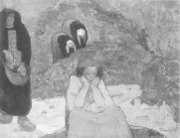 fig. 5
Paul Gauguin, Human miseries, 1888, Copenhagen, Ordrupgaard Samlingen 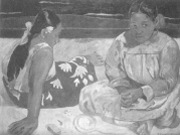 fig 6
Paul Gauguin, Women of Tahiti, 1891, Paris, Musée d'Orsay, bequest of the Vicomte de Cholet | |
Gauguin in French museumsThe first Gauguin painting entered a French museum in 1910.Ga naar voetnoot51 It was not a purchase but rather a bequest by the ceramicist Ernest Chaplet, who had died the previous year. The picture, a still life from Gauguin's impressionist period, Still life with oranges, was accepted by the consultative committee for museums on 7 April 1910.Ga naar voetnoot52 With this modest work, Gauguin entered the Musée du Luxembourg by the back door, and his canvas remained hanging there until 1929.Ga naar voetnoot53 Charles Morice commented ironically on the contrived and ridiculous resistance on the part of the painter's enemies: ‘Those whom he makes uncomfortable, sensing him grow, continue to resist him desperately, at least in his homeland. Soon we shall have to travel to Moscow to see Gauguin's Tahitian work.’Ga naar voetnoot54 ‘Let us note,’ added the columnist in L'Art Décoratif in 1912, ‘that there is no Manet, no Toulouse-Lautrec (oh yes, one study!), no Gauguin (one minuscule still life, a bequest what's more), no Cézanne, no Van Gogh, and only one Renoir, in the Musée du Luxembourg, outside the Caillebotte collection.’Ga naar voetnoot55 The creative artists who had made France's name abroad were strangely absent from the Musée du Luxembourg, which, as Apollinaire remarked in 1914, ‘contains nothing of the essence of living art over recent years.’Ga naar voetnoot56 On a few occasions, the state let slip a picture from the Arles period, for example Human miseries (fig. 5), which was offered as a gift in the spring of 1910 by Amédée Schuffenecker,Ga naar voetnoot57 or Study of a nude (Suzanne reclining), a canvas from the impressionist period that had been praised by Huysmans and was offered as a gift | |
[pagina 33]
| |
reserving usufruct by the painter Philipsen.Ga naar voetnoot58 From the 1920s on, thanks to bequests and giftsGa naar voetnoot59 but also to the first purchases, French museums began incorporating works by Gauguin into their collections in a significant way. Among the most important, we may point to the 1923 bequest by the vicomte Guy de Cholet of Women of Tahiti (fig. 6), and the gift in his memory made by his sister, the comtesse Vitali, Les Alyscamps, which was hung in the Musée des Arts décoratifs in the Pavilion de Marsan at the Louvre until 1938. In April 1913,Ga naar voetnoot60 the Lyon museum became the first French institution to actually acquire a Gauguin canvas, Nave nave Mahana (Jours délicieux), followed ten years later by Grenoble, which bought the Portrait of Madeleine Bernard from Bernheim-Jeune. Parisian museums did not begin purchasing until 1927, when Daniel de Monfreid sold The white horse (fig. 7) for the low price of 180,000 francs to the Louvre.Ga naar voetnoot61 The picture was finally accepted by the acquisition committee after a turbulent session in which Paul Jamot, assistant curator of paintings and drawings at the Louvre, and Robert Rey, assistant curator at the Luxembourg, were the only members to champion the work. Sensing the imminent danger of a refusal, Rey requested, against all normal procedures, a vote by name, thus ensuring that there would be no new Caillebotte affair.Ga naar voetnoot62 The most spectacular donation, in addition to Daniel de Monfreid's bequest of the Noa noa manuscript to the Louvre in 1925,Ga naar voetnoot63 was that of La belle Angèle, given by Vollard, who had bought it at the Degas sale. In February 1927, on the occasion of a speech by Robert Rey, the picture was loaned for one hour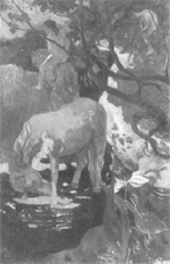 fig. 7
Paul Gauguin, The white horse, 1898, Paris, Musée d'Orsay to the pupils of the Ecole du Louvre. As preparations were being made to bring the canvas back to its owner, Vollard announced that ‘since La belle Angèle had come to the Louvre, he was proposing that it should stay there.’Ga naar voetnoot64 The | |
[pagina 34]
| |
gift was all the more appreciated since, as Rey later remarked, ‘given Gauguin's current popularity, La belle Angèle represents an enormous sum of money.’Ga naar voetnoot65 In this way, two masterpieces, one from the Breton period, the other from Tahiti, almost simultaneously entered the national collections, where Gauguin was as yet represented by only three canvases, two in the Musée du Luxembourg and one in the Musée des Arts décoratifs. These works, along with Noa noa, constituted the most sensational pieces in an exhibition of recent acquisitions held by the Louvre in March 1927 and praised in several enthusiastic articles. The national collections continued to be enriched during the Second World War, thanks to the Paul Jamot bequest, which in 1939 brought two pictures into the Louvre, The harvest in Brittany and The Seine at the pont d'Iéna, as well as a still life, Pas manger li, to the Musée des Beaux-Arts at Reims. In 1944, the Louvre bought Et l'or de leurs corps, which had been in the collection of Madame Olivier Sainsère. While Gauguin's painting was beginning to gain acceptance,Ga naar voetnoot66 a new interest in other forms of expression by this all-round artist was developing, although it took several more years before sculptures and objets d'art came into the national museums. Until 1952, all entered exclusively in the form of donations.Ga naar voetnoot67 A cane, a sculpted dagger and some ceramics joined the Louvre collections in 1938, donated by Jean Schmit, while the first sculptures, Saint Orang and Tahitian mask, became part of the national collections in late 1943, early 1944, thanks to a bequest by Lucien Vollard. 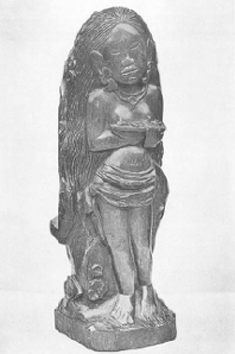 fig. 8
Paul Gauguin, Stele, 1892 (?), present location unknown | |
[pagina 35]
| |
Wood, pottery, engravingsIn November 1910, Eugène Blot held the first exhibition of Gauguin's sculptures, woodcarvings and pottery from Tahiti. These three-dimensional objects, with their rough, incongruous forms and lack of classical references and charm, excited the public's curiosity. Gauguin had fashioned unexpected images, filled with mysticism (fig. 8). His art, which up to then had been judged as quintessentially decorative, was henceforth endowed with a religious and spiritual dimension by the columnists' pens.Ga naar voetnoot68 By refusing to copy nature, Gauguin had reintroduced the sacred into art and his works were not simple barbaric curiosities. This conception of Gauguin as a mystical artist was strengthened by the discovery in 1923 in Tahiti of the manuscript ‘L'esprit moderne et le catholicisme,’ ‘forgotten’ by the government since the artist's death. In January and February 1928 the Musée du Luxembourg organised an exhibition on the theme ‘Gauguin sculpteur et graveur.’Ga naar voetnoot69 Conceived in two parts, it comprised 19 wooden sculptures; a number of decorated objects such as calabashes, canes and daggers; seven wooden engraving plates transformed into bas-reliefs; and nine pieces of pottery, as well as a collection of engravings assembled by Marcel Guérin, the author of an excellent catalogue of Gauguin's engravings that had been published in 1927.Ga naar voetnoot70 The sculptures provoked astonished comments. Was this plagiarism, an art copied from the Maoris, or aeroliths that had fallen from another planet wondered Robert Rey.Ga naar voetnoot71 These rough effigies, hewn directly with a penknife from precious wood or a simple piece of beam, revealed a whole philosophy in sculpture. But the mixture of the divine and the trivial, the symbolic and the utilitarian disconcerted the visitors, and many saw in these works nothing but an imitation of Maori fetishes, executed with the artifice of a European. The engravings, however, enjoyed a complete success. ‘The plates from the second Tahiti series are almost unknown,’ stated the exhibition catalogue. Very rare proofs, printed without a press by Gauguin himself, were on view. Three years later, a new exhibition of prints was held from 26 May to 14 June 1931 at La Pléiade, a gallery dedicated to the graphic arts. Gauguin was now regarded as the greatest wood engraver of the last 100 years. This interest in Gauguin's sculpture and engravings corresponded to a re-reading of his work and his contribution to contemporary art. By the end of the 1920s, the artist was regarded as the precursor of a return to exoticism,Ga naar voetnoot72 expressed in this period by the taste for African and pre-Columbian art, Russian ballet and surrealism. With time, Gauguin's ‘barbaric’ art had become classical, and the artist was henceforth regarded as a kind of ‘exotic Poussin, a Poussin who in ancient times would have preferred the savage.’Ga naar voetnoot73 Parallel to this re-evaluation of his work, on the eve of the Second World War there was a resurgence of curiosity in Gauguin's romantic and exotic life, giving rise to a number of publications, with titles such as Gauguin peintre maudit, La vie ardente de Paul Gauguin, Paul Gauguin, mon père, and Gauguin, le solitaire du Pacifique.Ga naar voetnoot74 People became attached to his objects as though they were relics.Ga naar voetnoot75 ‘Along with Van Gogh, Gauguin is certainly the most popular artist for a century. In this glory, his legendary life | |
[pagina 36]
| |
counts as much as his magnificent work. [...] Is it not the strange paradox of our society which places its great men in such impossible living conditions that it imposes special destinies, the better to glorify them later?’ asked Raymond Cogniat.Ga naar voetnoot76 Without any link with this popular infatuation, Gauguin remained an isolated and misunderstood artist, while the masses remained captivated by his legend: ‘After the art dealers, society has set the stamp on the genius of Van Gogh and Gauguin. In its museums, it offers up their works for the crowds to admire. [They] will not seek in the pictures of Van Gogh and Gauguin the secret of what they are told today are artistic successes, but traces of the sufferings and struggles of two pariahs [...].’Ga naar voetnoot77 The legend that had overtaken the two painters continued to enthral but it did not do justice to their art, which remained the province of a small European elite. One hundred years after his birth, Gauguin could still provoke plenty of criticism and this was probably why his centenary failed to be marked in 1948. | |
1948: a missed appointment‘A centenarian too long forgotten,’ ran the headline in the daily L'Aube in July 1948. While the Carlsberg Glyptothek in Copenhagen succeeded in organising a large-scale retrospective comprising 120 works, France was distinguished by its silence. In place of Gauguin, that year the museums chose to celebrate the centenary of the Revolution of 1848 and the bicentenary of the painter Jacques-Louis David. ‘A rather sinister piece of news has in fact been making the rounds,’ Charles Estienne recounted: ‘there will be no great retrospective, equal in importance to Van Gogh's last year, and which would have shown everyone the astonishing contemporary relevance of Gauguin's message. [...] No matter: whatever the difficulties may be, everything must be attempted to spare France (official or not) such shame.’Ga naar voetnoot78 Unfortunately the message was not heeded. Faced with this silence, some people wondered whether it could be that Gauguin still frightened people: ‘Has his revolt against a society which he did not believe tailored to human needs retained so much destructive force?’Ga naar voetnoot79 The artist was still perceived as subversive and his personal protest had a tendency to make people forget his body of work. Only a few publications marked this anniversary and the book by Maurice Malingue, Gauguin, le peintre et son oeuvre, with its 250 illustrations, had to serve as the centenary publication.Ga naar voetnoot80 The only display at a national level was an opera entitled Gauguin,Ga naar voetnoot81 a lyric drama in six tableaux with music by Federico Elizalde,Ga naar voetnoot82 whose world premiere was given on radio on 25 June 1948.Ga naar voetnoot83 The sole recording of this work, preserved today in the archives of the Institut national de l'audiovisuel, is unfortunately inaudible. For his native country, Gauguin was still hardly more than a hero from an opera or a novel. The essential facts of his life as an adventurer were more part of the public domain than his art, which was nonetheless much admired by a minority of artists and art-lovers. One other modest event occurred to celebrate this anniversary. This was a film evening given by L'Association des Amis de l'Art in the painter's memory, showing extracts | |
[pagina 37]
| |
from Tabou, directed by Murnau in 1930 (released 1931), and an anecdotal short film shot in Oceania by Renée Hamon, Gauguin, le solitaire du Pacifique, an ineffectual documentary ‘which claimed to lead us in the footsteps of Gauguin and which did not succeed at any time in reconstructing for us the climate which was to give birth to Gauguin's most accomplished works.’Ga naar voetnoot84 It was only a year after this ‘anniversaire manqué,’ during the summer of 1949, that France finally paid homage to the artist in the form of a major exhibition, organised by the Direction des musées de France at the Orangerie in the Tuileries, under the direction of Charles Sterling and Jean Leymarie.Ga naar voetnoot85 | |
The centenary retrospective, 1949Since the historical retrospective at the Salon d'Automne in 1906, three monographic exhibitions had taken place in Paris: one at the Galerie Dru in 1923, 20 years after the artist's death;Ga naar voetnoot86 another in 1931, at the Galerie du Portique, with around 40 canvases and ten sculptures; and a third, rather incomplete, at the Galerie des Beaux-Arts at the end of 1936.Ga naar voetnoot87 Minor exhibitionsGa naar voetnoot88 were also organised at the instigation of galleries and associations, with the exception of the exhibition of sculptures and engravings that was held at the Musée du Luxembourg in 1928. It was as much for reasons of arbitration as lack of credit that the exhibition marking the centenary of Gauguin's birth saw the light of day only a year after the actual event. The guiding principle of the show at the Orangerie was to celebrate the centenary of the impressionists. In a letter to the director of the French museums, published in the foreword to the catalogue, René Huyghe, chief curator in the department of paintings and drawings at the Louvre, set out the difficulties encountered in the organisation of such an exhibition, difficulties which still remain relevant today: ‘Assembling a Gauguin collection which is at once significant and extensive is not easy in our time, when it is becoming more and more tricky to make up the minds of overworked lenders or to push aside accrued obstacles.’ Works of art had already left France for English-speaking countries, Scandinavia and Russia. Gauguin had prophesised this situation when he wrote in 1897 to Daniel de Monfreid: ‘And a time will come when people will think I am a myth or rather an invention of the press; people will say where are these pictures? The fact is that there are not 50 of them in collections in France.’Ga naar voetnoot89 The exhibition in 1949 revealed a paradoxical situation: that of an artist at once isolated and glorified. It also provided an opportunity to draw up a mixed balance sheet on the Gauguin situation in France. | |
A singular artistAt the time of the 1949 retrospective, Gauguin, who had previously been thought to represent a certain idea of classicism, was perceived as the incarnation of the romantic artist,Ga naar voetnoot90 a creative genius, totally involved in what he did and who had created his own world. He had remained misunderstood because of the subjectivity of his art and ‘despite the success with which he is surrounded,’ | |
[pagina 38]
| |
analysed Raymond Cogniat, ‘he remains, even in the present, an isolated character, as does his work; despite the thousands of visitors, his body of work is also isolated, without any deep attachments with the other aspects of contemporary art, for solitude is one of the ransoms of genius.’Ga naar voetnoot91 Bernard Dorival wondered about the role of the 1949 exhibition: ‘Will it contribute towards returning to his place, a primary place which he shares with Cézanne and Van Gogh, a master whom critics - not always disinterested ones (recognition is burdensome to the Perrichons of painting) - had somewhat unjustly diminished, at least in the minds of the painters?’Ga naar voetnoot92 If it was still too soon, in 1949, to measure the full extent of Gauguin's contribution to the aesthetic revolutions of the 20th century, still several journalists recalled his role as an initiator on this occasion.Ga naar voetnoot93 He had dared to explore all the freedoms which led to the most advanced research, in particular in the area of the liberation of colour; ‘he legitimised the bold innovations of fauvism and of abstract art.’Ga naar voetnoot94 ‘He took - and with what decisiveness - the first steps into the brand-new world of what people have since called pure painting,’ added the journalist Paul Fierens. ‘And if he did not have a clear vision of it, he had a revelation, an intuition for it.’Ga naar voetnoot95 For Dorival, he was ‘the alpha of contemporary painting. And one might say as much for sculpture and ceramics, in which he produced astonishing works of art [...].’Ga naar voetnoot96 The impact of his works, which were much admired by artists at the beginning of the century - in particular by Matisse, whose Joie de vivre has been compared with the Tahiti canvases - diminished with the cubists from 1910 onwards, and as 1914 approached their influence touched only a handful of creative artists. Their literary side, their symbolic weightiness, attested by certain sententious inscriptions and a slightly facile exoticism, did the artist no favours, just as his adventures had discredited him in the public's eyes. | |
A committed artistThe ‘film’ of Gauguin's life and the bad literature he had inspired needed to be forgotten in order for the the artist to be appreciated as the first classicist of modern painting. The same was true of the fact that this man, a few of whose works France boasted of possessing, had ended up ostracised by society.Ga naar voetnoot97 If the fascination which Gauguin's complex genius exercised corresponded in the 1940s ‘to a general resurgence of interest in the strangest figures in the history of art,’Ga naar voetnoot98 people were scarcely beginning to decipher the significance of his message and become interested in his commitment. ‘Beyond Gauguin,’ wrote René Huyghe in the preface to the 1949 exhibition catalogue, ‘stands the problem of the current evolution of our civilisation.’ The artist had perceived the decline of the west and had raged against the dictatorship of Greco-Roman culture. Following in his footsteps, other artists wanted to go beyond the traditional frameworks of thought by taking an interest in the primitive arts, children's drawings, naive art, the art of the insane. Equally, the interest in the unconscious had opened up new perspectives. By giving shape to his interior world, Gauguin had manifested the anguish of the modern soul and the question of its destiny, bringing us to the edge of our own enigma without weighing it down with expectations. ‘He was able to place this enigma before us,’ wrote René Huyghe again, ‘when he asked in vain for death through an attempted suicide, in a canvas in which three cries ring out; cries that also went unanswered’ (fig. 9) But at the moment of official recognition a sad assessment had to be made. ‘Of all the great masters of | |
[pagina 39]
| |
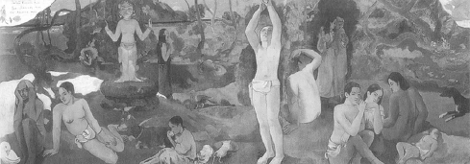 fig. 9
Paul Gauguin, Where do we come from? What are we? Where are we going?, 1897, Tompkins Collection (courtesy of the Museum of Fine Arts, Boston) the late 19th century Gauguin is in fact, with Seurat, the one whose masterpieces France was least able to hold on to, and one of the last to receive the official honours of the Orangerie.’Ga naar voetnoot99 All the same, at the time of the exhibition Jean Leymarie succeeded in bringing back to France, at least temporarily, a few works of art from foreign collections: The vision of the sermon (fig. 2), which since 1925 had belonged to the National Gallery in Edinburgh; The yellow Christ, ‘a work which contains in force all of fauvism,’Ga naar voetnoot100 kept at the Albright-Knox Art Gallery in Buffalo; Calvary from the Musées royaux des Beaux-arts de Belgique in Brussels; Ia orana Maria, ‘gateway to the Tahitian oeuvre,’Ga naar voetnoot101 which was then in a private collection in New York; Ta matete from the Kunstmuseum in Basel; Nevermore from the Courtauld Institute in London; and, last but not least, Where do we come from? What are we? Where are we going? (fig. 9), acquired in 1936 by the Museum of Fine Arts in Boston. |
|

